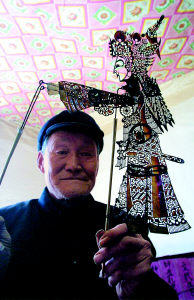 According to a survey made by the late writer Sun Kaidi, Chinese shadow play dated back to the mid-or lateTang Dynasty, or the laterFive Dynasties(907-960). During that period, it served as a media for the preaching of Buddhist Dharma of transmigration and retribution. In temples, shadow figures were used as the supposed souls of the dead when their sin was expiated after death by monk preachers in charge of public service.
According to a survey made by the late writer Sun Kaidi, Chinese shadow play dated back to the mid-or lateTang Dynasty, or the laterFive Dynasties(907-960). During that period, it served as a media for the preaching of Buddhist Dharma of transmigration and retribution. In temples, shadow figures were used as the supposed souls of the dead when their sin was expiated after death by monk preachers in charge of public service.
During the Song Dynasty, it became one type of the prosperous folk arts, combined with the genre of popular entertainment mainly consisting of talking and singing. According to the Records of the Origins of Events by Gao Cheng of the Song Dynasty, during the reign of Emperor Renzong, there were some people who could tell Romance of the Three Kingdoms stories or make puppets for a shadow play adapted from the stories. Hence the show of images of the wars among the kingdoms of Wei, Shu, and Wu has been handed down to the present.
In An Account of the Capital's Wonders published in the Song period, a general description can be found of the materials that were used to make shadow puppets and the development of their variations as well as the contents of performance. It says: "The shadow show is played by people in the capital with figures and patterns carved and cut out from whitepaperin the initial stage and later on from painted sheep's skin. And its text of dialogue is quite like a narrative textbook of history." The capital referred to here was Bianliang (today'sKaifengofHenan Province), the then capital of theNorthern Song Dynasty(960-1127).
In the painting entitled "The Festival of Pure Brightness on the River" by Zhang Zeduan, a well known Song Dynasty genre artist, a puppet show and the like can be seen as an entertainment activity enjoyed by the folks in the capital of Bianliang.
During the Song period, evidence for the prosperous shadow theater can also be obtained from the record of a newly emerging trade of professional craftsmen who carved and made shadow puppets. This professional trade was recorded in the Former Events in Wulin. Wulin was the capital of theSouthern Song Dynasty(1127-1279), and was also known as Lin'an (nowHangzhouinZhejiang Province). This proves that the shadow theater was further developed in the period from theNorthern Dynastyto theSouthern Dynasty. As the demand grew, craftsmen gradually formed a professional trade. At that time, there were different types of shadow play.
In the chapter titled "Capital's Entertainment Center and the Industry of Arts and Handicrafts" in the book The Eastern Capital: A Dream of Splendors Past, the record says, "Dingyi and Shouji play a kind of 'qiaoying show'."
